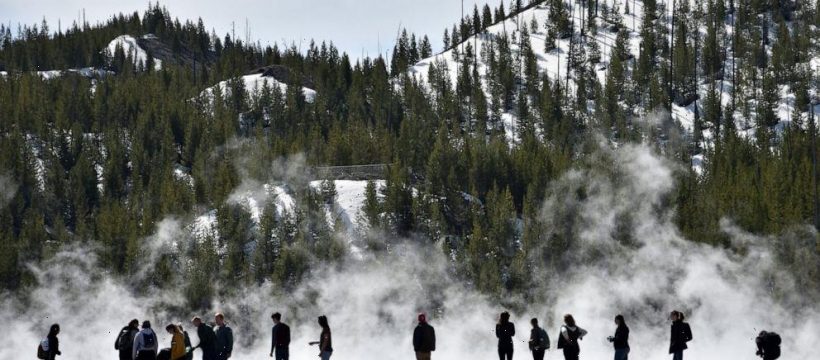HELENA, Mont. — Yellowstone National Park visitors hoping to see its world-renowned geysers, wolves and bears can expect warmer temperatures and less snow as climate change alters the park’s environment, according to a report by U.S. and university researchers released Wednesday.
Average temperatures in the Yellowstone region in recent decades were likely the warmest of the last 800,000 years, according to geologic studies. And average annual snowfall has decreased by nearly 2 feet (1 meter) since 1950.
The changing climate could affect some of the park’s most iconic sites, including Old Faithful, a geyser famous for erupting at regular intervals.
Past droughts have reduced the frequency of water shooting out of the popular geyser, meaning it could erupt less frequently as drought conditions become more common in the park, Bryan Shuman, a geology professor at the University of Wyoming, said during a news conference Wednesday.
Temperatures in the region have increased by more than 2 degrees (1 degree Celsius) since 1950 and are expected to increase by an additional five to 10 degrees (3 to 6 degrees Celsius) by the end of the century, according to findings by scientists with the U.S. Geological Survey, Montana State University and the University of Wyoming.
The report summarizes existing data and projected changes to temperature, precipitation and water in the Yellowstone region, which covers parts of Montana, Wyoming and Idaho. Researchers said they intend for the report to serve as a starting point for discussions on responding to the impact of climate change on the environment, local economies and ways of life in the region.
Communities in the surrounding area, including Bozeman, Montana, and Jackson, Wyoming, could see between 40 and 60 more days per year of temperatures above 90 degrees (32 degrees Celsius).
Also by the end of the century, visitors will likely see more rain, but higher temperatures will likely mean drier summers, increasing the wildfire risk.
These changes come as the park’s popularity has grown. In recent years, the park has seen around 4 million visitors each year. Park officials expect 2021 to draw a record number of tourists as coronavirus restrictions ease and travelers seek outdoor recreation.
Yellowstone Superintendent Cam Sholly said he is already noticing the effects of warming temperatures on recreation, including in winter. The season typically brings snowmobilers and others who rely on snow covering the park roads.
Winter recreation normally starts in late November or early December, but in recent years, there wasn’t enough snow to cover the roads as late as January, Sholly said.
He said the increased popularity of the park exacerbates some of the risks posed by climate change, including the introduction and proliferation of invasive species that can harm the region’s delicate ecosystem.
The changes also are likely to affect tribes that have called the region home for millennia.
“Climate change has the potential to fundamentally change the ecological processes that have defined and supported the tribes’ unique life ways,” said Chad Colter, director of the fish and wildlife department of the Shoshone-Bannock Tribes. “This creates an urgent need to build climate resilience to protect and preserve those resources for future generations.”
———
Samuels is a corps member for the Associated Press/Report for America Statehouse News Initiative. Report for America is a nonprofit national service program that places journalists in local newsrooms to report on undercovered issues.
Source: Read Full Article
